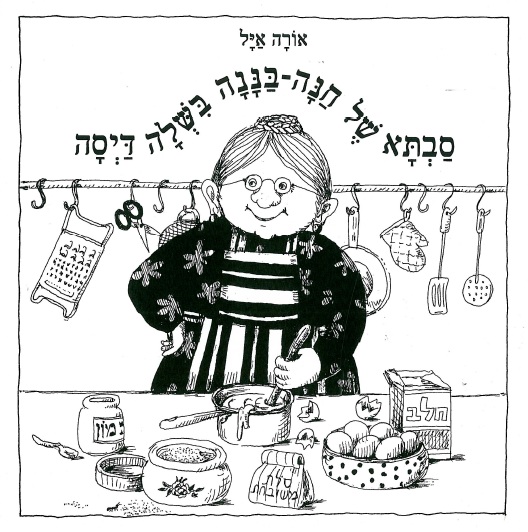סבתא של חנה בננה בשלה דייסה
תרגום לרוסית של ההצעות להורים המודפסות בדפים האחרונים של הספר
איירה וכתבה: אורה איל
Бабушка Ханы-Бананы варила кашу Ора Эяль
"Хана–Банана очень спешит домой к бабушке, которая живет в конце улицы ..." Тем временем, бабушка угощает кашей, которую приготовила внучке, соседей – и в конце не остается даже капли для Ханы-Бананы!
Бабушка расстроена и не знает, что делать, но Хана–Банана выручает ее, утешая любимую бабушку, и тем самым учит нас, как справиться с переменами в планах.
Гостеприимство: "Пусть будут двери дома твоего распахнуты настежь..." (Авот 1:5)
Бабушка Ханы-Бананы открывает свой дом и сердце голодным соседям и потчует их кашей, которую сварила. Как хорошо быть соседями бабушки! Еврейская традиция придает большое значение добрососедству и гостеприимству. На многие праздники мы приглашаем друзей и соседей присоединиться к семейному веселью и вместе принять участие в трапезе. В некоторых случаях соседи становятся своего рода «расширенной семьей» - мы заботимся о них, и проводим с ними время - так же, как с семьей.
Отношения бабушек и дедушек с внуками: «Венец стариков - сыновья сыновей, и слава детей – отцы их." (Притчи 17:6)
Так же как у Ханы-Бананы с бабушкой, у многих внуков есть особенная связь с бабушками и дедушками. Притчи описывают это образно: внуки, как венец на голове взрослого, относятся к нему с уважением и радуют его. Сыновья и внуки гордятся своими отцами, их личным примером и жизненным опытом.
Рассказ "Бабушка Ханы-Бананы варила кашу" описывает глубокие и добрые отношения между поколениями в семье.
Бабушка и внучка с удовольствием общаются, заботятся друг о друге, и внучка проявляет особое умение успокоить бабушку.
Oрa Эяль (1946-2011)
Oрa Эяль написала и проиллюстрировала более 70 книг для детей. Она проиллюстрировала множество книг лучших израильских авторов, в том числе Мирьям Рут («История пяти воздушных шариков», «Горячая кукуруза» и «Домик Яэли» - "חם תירס" ,"בלונים בחמישה מעשה" "יעל של הבית"ו), Давида Гроссмана (серия рассказов «Итамар» - "איתמר") и Ронит Хахам («Пять ведьм вышли на прогулку» - "לטייל הלכו מכשפות חמש"). Из книг, которые Эяль написала и проиллюстрировала сама, назовем: "В одно прекрасное утро", "Огбо", "Великая война" - "האדירה המלחמה" ,"אוגּבו" ,"אחד בהיר בוקר", и многие другие. Стиль иллюстраций Оры очень прост и легко узнаваем, ее книги радовали и продолжают радовать тысячи израильских детей. Ора Эяль получила множество наград, в том числе медаль Ганса Христиана Андерсена в области детской и юношеской литературы, а также приз Бен-Ицхака.
Занятия в кругу семьи
- Если вы проследите за словами рассказа и сопровождающими их иллюстрациями, вы, конечно, обратите внимание на несоответствие между иллюстрациями и текстом. Можно прочитать рассказ еще раз. Каждый раз, когда вы доходите до слов: "А тем временем Хана-Банана очень спешит...", можно попросить детей описать, что они видят на картинке. На самом ли деле Хана-Банана "почти не останавливается?"
- Заметили ли вы кота, который сопровождает Хану-Банану к бабушке? Вы можете попросить ваших детей показать вам, где находится кот на каждой странице, и спросить их, рада ли ему бабушка.
- Вы можете поиграть с вашими детьми в игру "Бабушка варит кашу". Согласно сюжету книжки "Бабушка Ханы-Бананы варила кашу" кого она угостила, а кому не досталось?
- Рассказ "Бабушка Ханы-Бананы варила кашу" - это на самом деле два рассказа, происходящих в одно и тоже время. Вы можете сделать их параллельную инсценировку. Вначале попросите своих детей сыграть сценку "Хана-Банана по дороге к бабушке" пока вы представляете, что делает в это время бабушка. Затем вы можете поменяться местами. Если рядом с вами есть родственники или друзья, они могут принять участие в роли соседей.
- " На вкус и цвет ...". В конце книжки Хана-Банана признается, что ей не так уж и нравится каша. Спросите своего ребенка, считает ли он, что Хана-Банана действительно не любит кашу? Какую еду они особенно любят, а какая им нравится меньше?
- Вы можете объяснить своему ребенку, что "Хана-Банана" - это ласкательное обращение к девочке. Если у ваших детей есть такие ласкательные имена, то кто и когда им пользуется? Есть ли у них прозвища, которые им не нравятся?
Как приготовить горячую и сладкую манную кашу?
Ингредиенты:
Стакан воды, 2 стакана молока, 3-4 столовые ложки манной крупы, 3 столовые ложки сахара, корица, масло.
Приготовление:
Смешать воду, молоко, манную крупа и сахар в маленькой кастрюле, помешивая, довести до кипения.
Каша будет готова, когда смесь закипит и крупинки манки сварятся. Подавать горячей с кусочком масла и корицей.
Приятного аппетита!
Мы желаем вам приятного чтения и обсуждения книжки!





